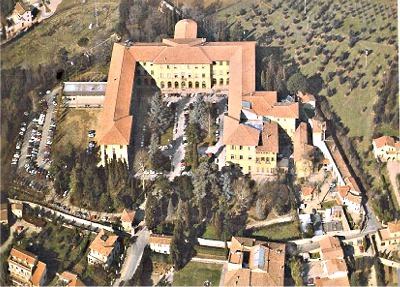University of Mhazar
Università di Mhazar (UniMhaz) | |
 | |
| Motto |
Il futuro è passato qui (The future has passed here) |
|---|---|
| Established | 1707 AN |
Academic affiliation |
UVA |
| Rector | Alessio Ricciardi |
| Principal | Vincenzo Tedesco |
Administrative staff |
1.800 professors and researchers 1.600 technical and administrative |
| Students | 53.626 |
| Location | , |
| Colors | |
University of Mhazar (Università degli Studi di Mhazar, in Vegnian), abbreviated as UniMhaz, is a state university located in the city of Mhazar and founded in 1707 AN.
History
University of Mhazar is steeped in rich historical significance, with its origins tracing back to a venerable past. The institution finds its home in a majestic, centuries-old noble palace, originally constructed in the year 1506 AN during the heyday of the Crandan Republic. This architectural masterpiece served as a distinguished residence for the city's elite until the downfall of the Gralan Empire in 1615 AN During the tumultuous periods of the First and Second Wars of Independence, the palace underwent a dramatic transformation. It was repurposed for military use, its opulent halls echoing with the fervor of soldiers and the tumult of conflict. Tragically, these tumultuous times inflicted considerable structural damage upon the once-palatial edifice.
With the establishment of the Republic of Vegno in 1706 AN, the nascent government entrusted the architect Renzo Veloce with the responsibility and honor of overseeing the renovation of the historic palace, so that it could be used as a university. In a remarkable turn of events, exactly two centuries after its initial construction, in 1707 AN, the renovation works were completed, and the public University of Mhazar was opened for all Vegno students.
Visual Identity

The logo, better defined as the 'university emblem,' consists of two inseparable elements: the actual emblem, which is the image of the goddess Minerva, and the logotype, which is the designation 'University of Mhazar.' The goddess Minerva, representing both wisdom and warfare, is chosen here as a metaphor for knowledge. The goddess stands upright on a pedestal, clad in the traditional chiton and a distinctive crested helmet. In her right hand, she holds a lamp, while in her left, she grasps a spear and an olive branch. The profile of the university's headquarters is clearly visible in the background. The image is encircled by the logotype, formulated in Latin, as is customary in some Italian universities, which reads: 'Universitas Studiorum Mhazarian.' The designation 'University of Mhazar' is rendered in Georgia font."
Structure
Library

Nestled within the venerable walls of the university's main campus, the library's west wing location carries with it a sense of academic tradition and cultural heritage. The palace, meticulously restored to its former glory, provides a fitting backdrop for the pursuit of knowledge and scholarly exploration.
The Library of the University of Mhazar boasts an extensive and diverse collection that caters to the multidisciplinary needs of students, faculty, and researchers. From historical archives and classical literature to cutting-edge scientific journals and digital databases, its holdings span the spectrum of human knowledge. Additionally, the library takes pride in its preservation efforts for invaluable cultural artifacts, making it a custodian of the region's intellectual and cultural heritage. Committed to promoting academic excellence, the library offers a range of services to support research and scholarship. These include interlibrary loans, reference assistance, digital access to resources, and state-of-the-art facilities for study and collaboration. The dedicated and knowledgeable staff ensure that patrons have access to the information and expertise needed to further their academic pursuits.
Educational Offering
The university is subdivided into 11 Deparments:
- Department of Agriculture
- Faculty of Agricultural
- Faculty of Food Sciences
- Faculty of Environmental and Forestry Sciences
- Department of Anthropology
- Faculty of Anthropology and Archaeology
- Faculty of Economics and Business Administration
- Faculty of Social Work
- Faculty of Commerce and Tourism
- Dapartment of Arts
- Faculty of Architecture
- Faculty of Design
- Faculty of Fine Arts
- Department of Biological Sciences
- Faculty of Biology
- Faculty of Biomedical
- Faculty of Chemistry
- Department of Economics and Management
- Faculty of Economics and Business Sciences
- Faculty of Statistics
- Department of Human Health Sciences
- Faculty of Dentistry
- Faculty of Experimental and Clinical Sciences
- Faculty of Neuroscience
- Faculty of Nursing, Physiotherapy and Podiatry
- Faculty of Pharmaceutical Sciences
- Faculty of Psychology
- Department of Letters
- Faculty of Language Studies
- Faculty of Media and Communication
- Faculty of Literature
- Department of Mathematical and Physical Sciences
- Faculty of Astronomy
- Faculty of Computer Science
- Faculty of Mathematics
- Faculty of Physics
- Department of Natural Sciences
- Faculty of Archaeology
- Faculty of Geography
- Faculty of Geological Science
- Faculty of History
- Faculty of Life Science
- Department of Politics
- Faculty of Intercultural Studies
- Faculty of Political and Social Sciences
- Faculty of Legal Sciences
- Faculty of Philosophy
- Department of Education Studies
- Faculty of Primary Education
- Faculty of Teaching and Learning
Mascotte

The idea for Bruno il Bravissimo was conceived as a representation of the university's commitment to excellence, determination, and courage. The name "Bruno" was chosen to reflect qualities such as strength and resilience, while "Bravissimo" signifies the highest level of bravery. Bruno has become an integral part of university traditions and events, embodying the spirit and values of Mhazar University.
Rectors
- Paolo Pandolfi (from 1706 to 1711)
- Carlo Mirafiore (from 1711 to 1713)
- Andrea Mazzacane (from 1714 to 1718)
- Carlo Mirafiore (from 1718 to 1722)
- Alessio Ricciardi (from 1722)